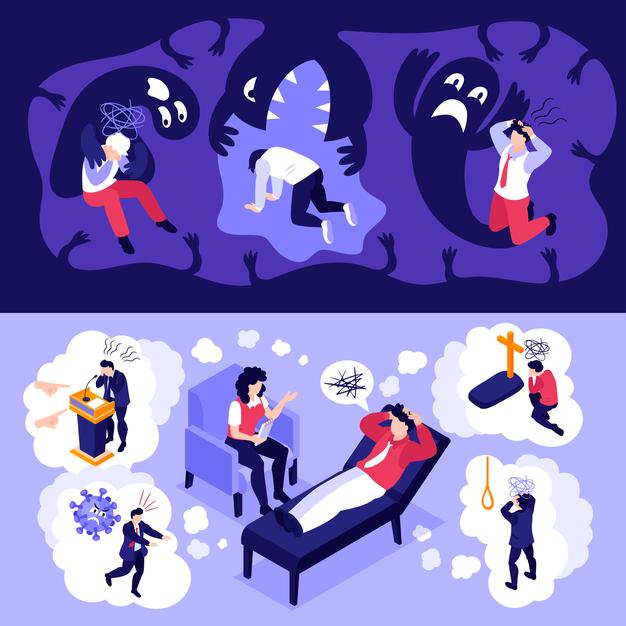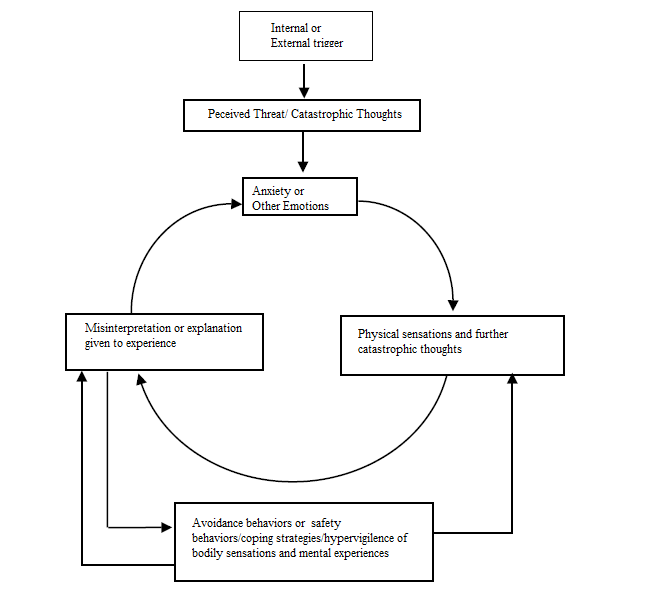A Quick Guide
A panic attack is a state of intense fear that brings catastrophic thoughts, feelings, and severe physical reactions to the body. The person fears dying, going crazy, losing control, having a heart attack, etc. Such thoughts intensify the physical symptoms and take them to a peak within a few minutes. Each person has a unique panic attack cycle depending on what triggers them, what thoughts they have, and how they cope with it. So, the present article will discuss how to understand your unique panic attack cycle.
The typical cycle of panic attacks
According to David M Clark (1986), a series of events occurs in a panic attack which upon repetition leads to the development of a full-blown panic disorder. In short, it’s a cycle of ‘thoughts, emotions, sensations’ which can start at any point and keeps on repeating. The following happens in a typical panic attack cycle:
- A stressor or biological factor triggers a normal physical or psychological response in a person e.g. increased heart rate, breathing difficulty, pain in the body, etc.
- The person misinterprets this normal response and gives it an incorrect catastrophic explanation. He / She starts to believe it. e.g. increased heart rate may be interpreted as ‘I am having a heart attack’.
- This belief in the incorrect explanation aggravates the pre-existing physical and psychological response. Accordingly, the increased intensity of symptoms further strengthens the belief in the incorrect explanation and continues the loop. e.g. ‘I am having a heart attack’ follows by increased anxiety, heartbeat, and other symptoms. This leads to ‘This proves it. I am having a heart attack and I will die’ and so on.
- The person develops ineffective safety and avoidance strategies to tackle future panic attacks which trigger even more panic attacks. e.g. The person becomes more vigilant of his heartbeat and a slight change in it triggers another panic attack.
- He / She believes these strategies prevent panic attacks and continues to perform them. This perpetuates panic disorder. e.g. ‘If I am vigilant of my heartbeat rate, I can prevent the panic episode before it happens’.

Your unique panic attack cycle
To understand your unique panic attack cycle, try to track this sequence in a recent panic episode you experienced. You need to recount:
- The symptoms of anxiety or physical reactions that started the cycle.
- Figure out how you interpreted and explained them.
- Rate how much you believed this explanation during the panic episode.
- Track how it influenced your pre-existing symptoms of anxiety, physical reactions, emotions, and thoughts.
- List down how you coped with it. What strategies did you use and whether you started to be more hypervigilant of what is happening in your mind and body?

Ask yourself the following questions about your recent panic episode
Slowly start to remember from a few seconds before your panic episode. Ask yourself the following questions to understand what happened.
- When was your most recent episode of a panic attack? What was happening around that time?
- What was the first thing you noticed which indicated that you might start to panic? This could be a thought, emotion, or sensation in your body.
*Ask all of the 3 questions below on thoughts-emotions-sensations that happened in your experience in the order they occurred for you: - For thought ask= When you noticed that thought, how did that make you feel? What was that emotion?
- For emotion ask= When you had that emotion, what sensations did you experience?
- For sensation ask= When you noticed that sensation, what thought went through your mind?
- What explanation did you give yourself about what was happening?
- How much did you believe this explanation during the panic episode?
- How did this explanation affect your anxiety?
- Did you do anything to prevent this ‘explanation’ from happening? What was it? Or Did you do anything to decrease your anxiety? What was it?
- Since having a panic attack, are you now more aware of your thoughts and bodily sensations? In what way?
The Panic Attack Cycle Illustration
Map out the following chart according to your answers:

We hope you found the above explanation useful and can understand your unique panic attack cycle. If you want to know the underlying mechanism of a panic attack and a panic disorder in detail, check out our previous article on The panic attack cycle: What happens when you have a panic attack? If you want to know more about panic attacks and how to identify them, read about them on our website.


